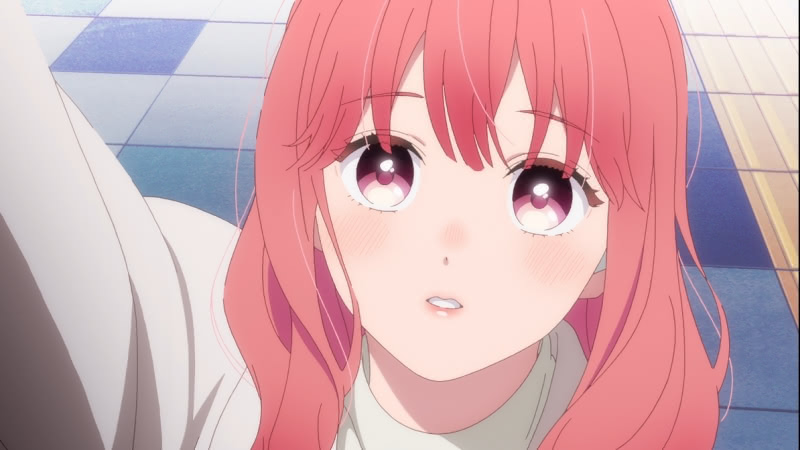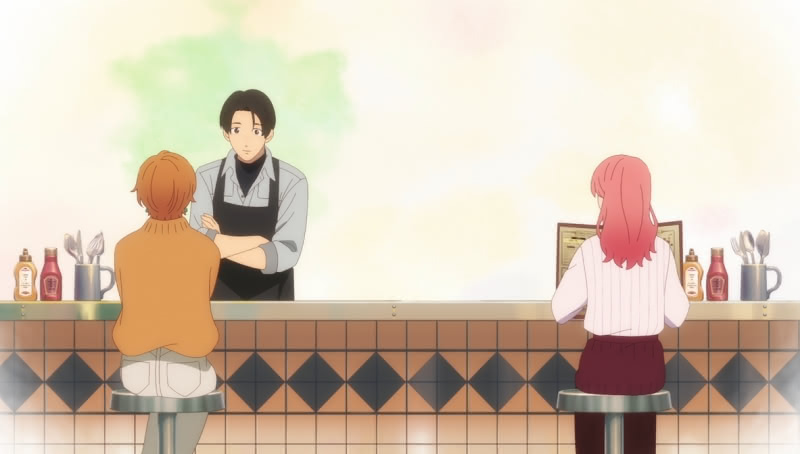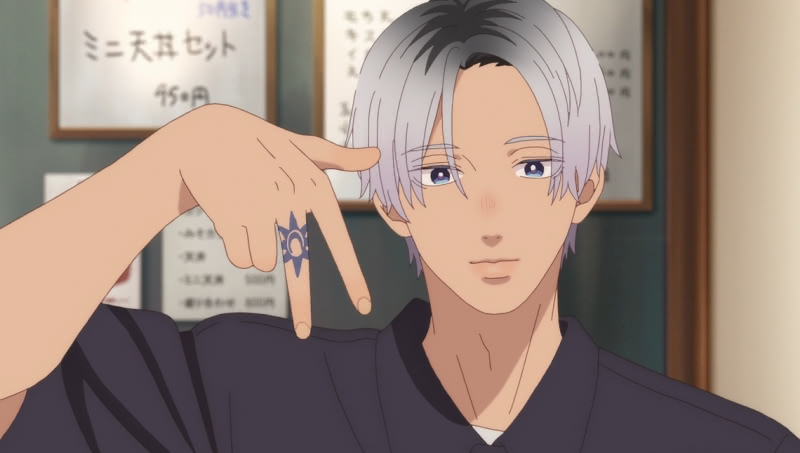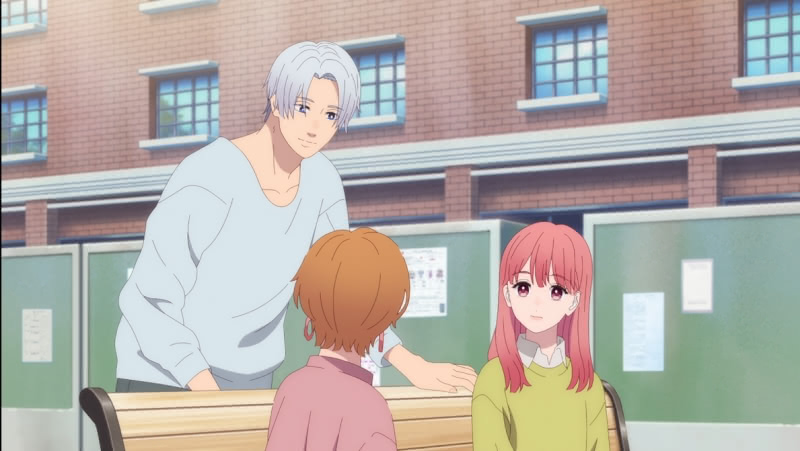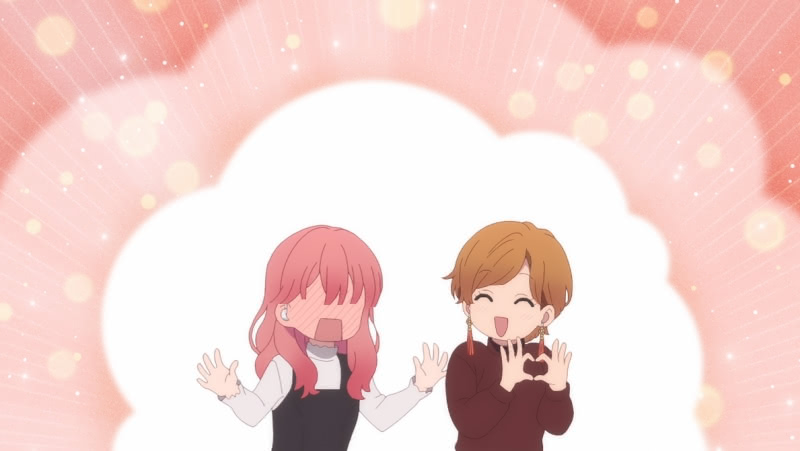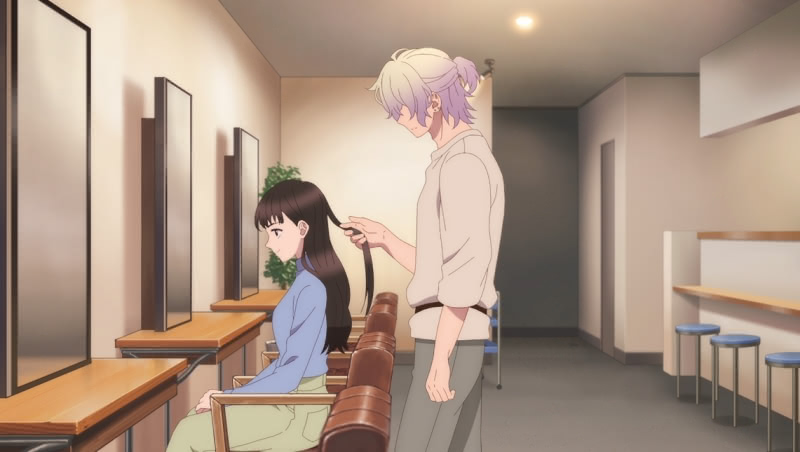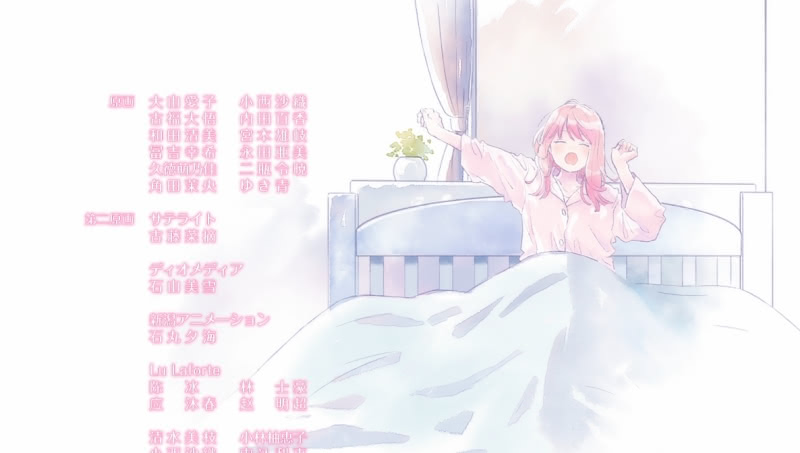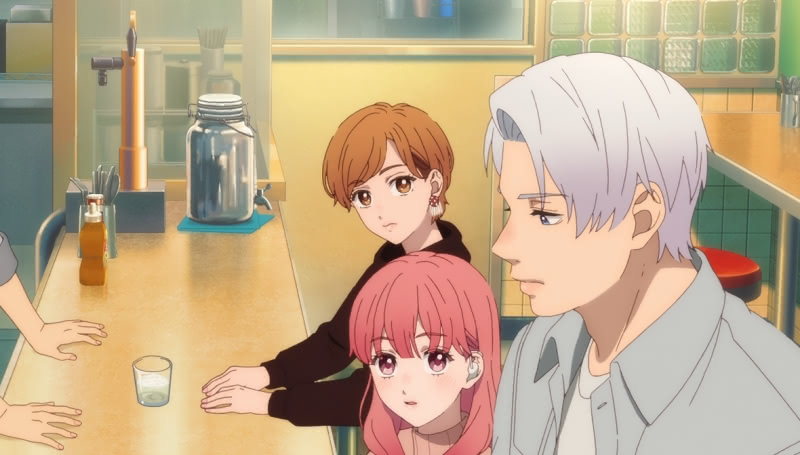I wrote five articles about hair color in the A Sign of Affection anime adaptation of a manga series of the same name. The first (and to date, only) season of the anime aired for 12 episodes from January 6, 2024, through March 23, 2024. Having already written extensively about the series’ admirable attention to detail in the area of hair dye discourse, I decided to write a more serious critical review of the series now that it is completed.
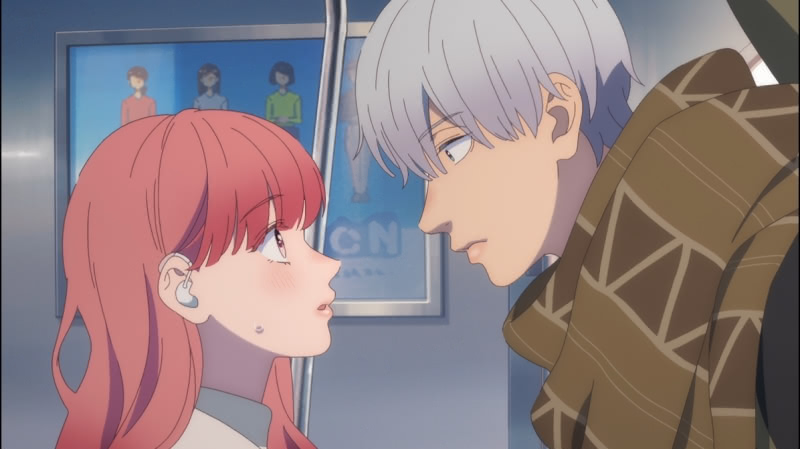
The name of the series, A Sign of Affection, is a reference to the primary view-point character, a 19-year old college student named Yuki Itose. Yuki is deaf and has been since birth. She communicates through lip reading, writing, and, of course, sign language. Her world changes when she meets a 22-year old student at her college, Itsuomi Nagi. He is a tall, attractive, multi-lingual young man who loves to travel and seldom shows emotion. Despite their differences, Itsuomi and Yuki quickly fall for one another. The cast is rounded out by other characters, most of whom are in the same age bracket and, with one exception, have some initial ties to Itsuomi.
A Note on Spoilers
I usually write my anime reviews in a major spoiler-free manner in order that they may be useful to people who are considering watching the series in question in addition to people who watched the series and are interested in my take on it. I will largely follow that rule here with one exception. I will reference the outcome of the Yuki-Itsuomi courtship because I do not think it is possible to write a meaningful, even generally spoiler-free review, without acknowledging it. If you are absolutely certain that you are going to watch the series, you can decide whether to watch before reading my review. However, I think my flexibility on the spoiler rule will make this review more informative for people who are deciding whether to try A Sign of Affection and more interesting for people who have already watched the series. You will find another warning in the overview section before I discuss the potential spoiler point.
Anime Details
A Sign of Affection, Yubisaki to Renren in Japanese, is an ongoing manga series by suu Morishitia (pseudonym) that began running on July 24, 2019. The manga has been collected in 10 volumes through December 13, 2023, and the first seven volumes have already been released in English. The anime adaptation, which I noted aired from January 6 through March 23 of of 2024, covers generally the first six volumes of the manga.
| English Anime Title | A Sign of Affection |
| Japanese Title | Yubisaki to Renren |
| Aired | January 6, 2024 through March 23, 2024 |
| Studio | Ajia-do Animation Works |
| Director | Yuuta Murano |
| Based On | Manga by Suu Morishita |
| Links | Wikipedia. ANN. MAL. AniDB. IMDB. |
Crunchyroll holds the English license for the anime series and aired it as a simulcast outside of Japan.
Overview
Yuki Itose (voiced by Sumire Morohoshi), a 19-year old college student, is the primary (but not exclusive) view-point character of A Sign of Affection. She suffers from congenital hearing loss. I noted in my article on Yuki’s hair color, referencing events from the second episode of the show, that college is Yuki’s first experience in a non-specialized school. She had attended a school for the deaf with a small number of classmates with hearing loss before she decided to try going to college (as we know, she was successful).
Yuki has a chance encounter on the train to school one day when a dashing young man saves her from an awkward situation wherein an English-speaking tourist asks her for directions (it should go without saying that Yuki cannot lip-read English). Yuki, who had previously said in a monologue that she did not know what it was like to fall in love, is immediately taken by the tall English-speaking gentleman who does demonstrate an occasional lack of regard for personal space. Said tall English-speaking (not to mention Japanese and German-speaking) gentleman, 22-year old Itsuomi Nagi (voiced by Yuu Miyazaki), turns out to not only be Yuki’s upperclassman in college, but also an acquaintance of Rin Fujishiro (voiced by Kaede Hondo). Rin is Yuki’s best friend in college and helps Yuki take class notes. Fortunately for Yuki, Rin likes Itsuomi’s older cousin, Kyouya Nagi (voiced by Ryouta Ousaka) and, for that reason, frequents the bar/restaurant that Kyouya runs and where Itsuomi works part time. Even more fortunately for Yuki, the worldly Itsuomi was immediately taken by her and her signing in their chance meeting on the train.
(Note: Itsuomi’s English comes with an accent but it is unusually solid by anime standards. I tip my hat to his voice actor, Mr. Miyazaki.)
Rin brings Yuki to Kyouya’s restaurant where Itsuomi is working, and Yuki is surprised to find that Itsuomi is interested in talking to her and getting to know her. Moreover, Itsuomi expresses an interest in sign language, which prompts Yuki to write a guide for him (the multi-lingual Itsuomi proves unsurprisingly to be a quick learner). They gradually get to know one another and begin meeting without the help of Rin – thanks in part to the fact that Itsuomi is unusually proactive for a character in this sort of anime romance. The budding relationship does run into a few delays thanks to Itsuomi’s tendency to travel abroad for weeks at a time – but it is refreshing free of melodrama and avoids the use of contrived misunderstandings to create drama.
Yuki and Itsuomi are the two main characters. While Yuki is the primary view-point character, a case can be made that Itsuomi is the most important character in the first season. Itsuomi’s initiative and perceptiveness with regard to Yuki is the main plot driver in the show. Despite Yuki being the primary view-point character, most of the cast is more closely connected to Itsuomi.
Rin, who I noted above, provides emotional support to Yuki, and she is the only person Yuki confides in about Itsuomi. Yuki returns the favor by encouraging Rin in her pursuit of Itsuomi’s older cousin, Kyouya. Kyouya takes an interest in Itsuomi’s increasingly obvious interest in Yuki, but Itsuomi is usually content to work out his feelings on his own.
Yuki has a childhood “friend” named Oushi Ashioki (voiced by Takeo Outsuka). Oushi is also a student at Yuki’s college, he has known Yuki since they were little after meeting Yuki through his older sister. Oushi is fluent in sign language when we first meet him, and he is the only person Yuki knows outside of her pre-college classmates (one of whom plays a minor role later in the series) who knows sign language. Oushi is childish and over-protective and has a tendency to tease Yuki or condescend to her. We learn early on that he was opposed to her going to college and he immediately dislikes Itsuomi. However, it does not take a literary scholar to piece together that Oushi’s often-unpleasant behavior is covering for his own feelings for Yuki, which he is unable to express to her despite being able to converse with her in sign.
Two of Itsuomi’s friends from high school (they are presumably about 22), Shin Iryuu (voiced by Tasuki Hatanaka) and Ema Nakasono (voiced by Nao Touyama), receive significant screen-time and the better part of at least one episode. Shin is a hair stylist and Itsuomi’s best friend (he is also friends with Kyouya) . Shin is also Ema’s best friend. (Neither Shin nor Ema are shown to attend college.) Ema is introduced as being in love with Itsuomi, notwithstanding the fact that Itsuomi shows no interest romantic in her. Shin ends up being the more significant of Itsuomi’s high school friends because of a few of his interactions with Itsuomi and because his peculiar friendship with Ema forms the series’ most notable sideplot that does not directly involve Itsuomi (in the present, at least) or Yuki.
The “spoiler” I referenced is forthcoming.
A Sign of Affection is classified as a shoujo manga, meaning a series targeted at girls. I think it has an older target audience, but that aside – these sorts of romances often feature the intended couples circling each other. For example, I wrote briefly about (not a review) My Love Story with Yamada-kun at Lv999 last year. That series is also centered on a budding romance but spends almost the entirety of its run trying to avoid resolving it. I looked at a series with a similar phenomenon (albeit with a male rather than female target demographic) in The Angel Next Door Spoils Me Rotten. A Sign of Affection takes a different course (see my review). Itsuomi is confident in his feelings for Yuki and confident in expressing his feelings to Yuki. They are ultimately able to resolve their feelings before the season reaches its half-way mark. Thus, just under half of the series focuses on Itsuomi’s and Yuki’s courtship and the longer second part of the series focuses on them as a couple (note, however, that some of the second-tier characters receive more screen-time in the second half).
My Review
I am usually an anime only viewer as in I watch anime without being familiar with the underlying source material. A Sign of Affection was a rare case where I actually had some familiarity with the source material – having read some of the early chapters when they were being simulpubbed on Kindle Unlimited a few years ago. I thought the manga was decent but unremarkable. That alone would have led me into the anime with middling expectations, but my hopes were raised when I saw the high quality aesthetics (animation, color palette, background music) in a preview before the season started. The anime, which is a faithful adaptation of the part of the manga I had read (insofar as I recall it), elevated the source material with its strong aesthetics and led to what was in the end a strong final product – so strong that it would have placed third on my 2023 anime of the year ranking had it aired one season earlier. Below, I examine why my overall impression is positive but also what it lacks that keeps it from being a plausible anime of the year type final product.
I was interested to see how the series would handle Yuki. Limiting ourselves to anime series only, Yuki is the first deaf view-point character I recall seeing. We are told in the series that Yuki’s hearing aids allow her to hear some sound but that her deafness is such that she cannot distinguish among sounds. A series with a deaf protagonist can employ different approaches to putting the viewer in her shoes, from aggressive approaches where sound is removed from the world in some of her scenes to subtler approaches where we simply watch the character in the world without being in her shoes. A Sign of Affection errs toward the second approach. Although Yuki never speaks in the series (she addresses that point), her internal monologue probably has the most speaking lines in the show. There are a few instances where we are actually put in Yuki’s shoes with a proverbial white noise soundtrack with no dialogue outside of Yuki’s monologue, but for the most part the series shows the audience how Yuki interacts with the world more than it tries to make the audience be Yuki. That the series is not seen entirely through Yuki’s eyes (there are a few episodes where Yuki is not even the main character) further r that the objective of the show is to allow Yuki to tell the audience about her world.
A Sign of Affection appears to show great attention to detail in how it portrays Yuki’s deafness (I say appears because I am not an expert on the subject). The Wikipedia entry for the series noted that the manga researched how deaf people navigate the world before drawing the manga. A Sign of Affection shows its class and writing caliber in how it clears the way for Yuki to explain her particular experience as a deaf person. Many anime series of less writing class resort to info dumps – one character going on a long, unnatural discourse about something or other – to convey information to the audience. A Sign of Affection could have fallen victim to this had Yuki only discussed her deafness in internal monologues or if it used a different character to pontificate about her. Instead, Yuki is given the opportunity in natural interactions – most often with the interested Itsuomi – to explain in her own words what it is like to live in her world. We learn from Yuki that she cannot distinguish among sounds even with her hearing aids on, how she learned to read lips, things that can make lip reading challenging (that she was born deaf is relevant here), and why she only seldom speaks. Itsuomi brings great value to Yuki, and by extension to the audience, in his having a specific interest in wanting to understand her world. There are a few points where Yuki naturally provides more general knowledge – For example there is one very interesting scene late in the series where Yuki explains in response to a question why one of her deaf school classmates was simultaneously speaking and using sign language on a video call. There are only a few scenes wherein another character, almost always Oushi, reprimands another character for inadvertently approaching Yuki in a way that neglects her deafness – but these too occur naturally.
The depiction of Yuki’s deafness is greatly aided by A Sign of Affection’s aesthetic production values, which are consistently outstanding. The show uses a soft color palette and pays very close attention to character appearances – something that allowed me to write five articles on hair color in the series. I dare say that it is the prettiest (in terms of animation) romance series I have seen since Blue Spring Ride in 2014. The animation – especially in the shows’ decent number of sign language scenes, has a notable physicality that is rare in anime and the most on point since my 2017 anime series of the year, Tsuki ga Kirei. A Sign of Affection has a consistent animation quality from episode to episode, even in the seemingly less important sequences. It does take some breathers when it chibi-fies Yuki and other characters with against a blank monochrome background or when it indulges in the sparkles and bubbles that always find a way into these types of shows. It also sometimes flattens the faces of characters to give them exaggerated expressions, most often used with Yuki and Itsuomi.
Nevertheless, A Sign of Affection is an elite production for the genre. It has an extra aesthetic gear beyond the norm for some important scenes – see, for example, Yuki’s episode 2 school flash-back which was the prettiest sequence of the series (the final episode had at least one scene that gives the episode two flash-back a good challenge).
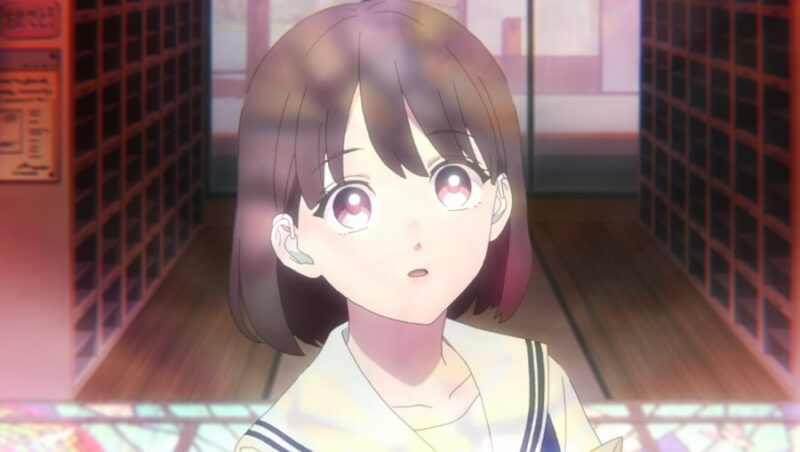
Much work went into depicting the characters and I found the character designs to be true to the manga. This is an attractive cast by anime standards even considering that romance series with a female target demographic tend to have attractive men. I dare say that Yuki, who is noted as being cute, and Oushi, who seems to be handsome enough for all normal purposes, are the most normal looking characters in the cast. Itsuomi is tall and often acknowledged in the show’s world as being unusually handsome, and Shin looks like he could transition to being an idol if he ever tires of being a hair stylist. Itsuomi’s older cousin Kyouya is also notably attractive and Ema is quite pretty and stylish. The series also gives its cast many outfits – showing as much detail there as it does when it comes to hair color. One interesting character animation note is that the series pays special attention to animating lips – I dare say I do not recall a cast of characters with more detailed lips. This makes sense when you consider that Yuki’s primary mode of understanding people other than Oushi is lip reading.
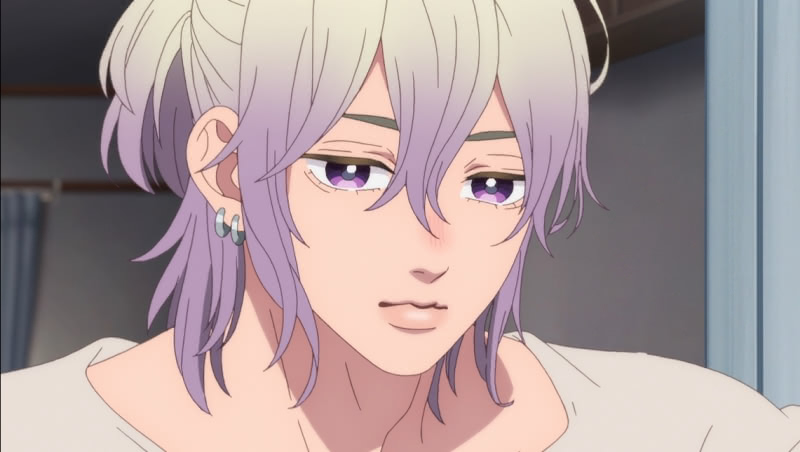
While Yuki is the principal view-point character of A Sign of Affection and the series’ defining character, the true protagonist of the first season is Itsuomi. Every significant event that occurs in the first season, from Yuki and Itsuomi becoming a couple to the progress that everyone in the rest of the cast makes, is at least partially related to Itsuomi’s falling in love with Yuki and showing unusual maturity for an anime character in not only acting on his feelings rather than guarding them to avoid the possibility that he could be disappointed. This is not to say that Yuki does not play a significant role in making the relationship happen (especially when one considers that her frame of reference is much smaller than Itsuomi’s), but the set-up requires Itsuomi to take the lead and he rises to the challenge. There is some irony – most likely intended – in the fact that Yuki, a deaf girl, and Itsuomi, a young man who only begins studying sign language after meeting Yuki, are the first two characters who are able to communicate their feelings to one another clearly despite their initial communication barriers.
This segues into what makes A Sign of Affection a very well put-together piece: The writing pays similar attention to detail to the animation. For example, one reviewer remarked that it seemed odd that Yuki, a 19 year old young woman, says she never had never had a crush before in the series’ opening monologue. I noticed this as well, but to the series credit – it does account for it in the first two episodes when we learn that Yuki attended a small school for the deaf prior to attending college, that she does not know anyone at college who knows sign language other than Oushi, and that her parents seem to treat her like she is younger than 19. Now the extent to which one thinks this is a sufficient explanation of Yuki before meeting Itsuomi may vary, but the series does at least consider the issue in fleshing out Yuki’s character. The series also gives an unusually thorough account of why Yuki likes Itsuomi and why Itsuomi likes Yuki. The particulars are beyond our scope – but I submit for the record that the writers did more to think about what brings these two people with dramatically different life experiences together than what we usually see in anime romances. The attention to detail covers some non-romantic points. For example, Yuki explains why she decided to attend college despite never having attended a non-specialty school before, and Itsuomi eventually explains why he loves traveling and studying languages.
Itsuomi is portrayed interestingly with respect to perspective. While Itsuomi is at a minimum the co-main character of the season, we are never taken inside his head. Itsuomi has scenes without Yuki, but we are never treated to his monologues. We always see Itsuomi through the eyes of another character (usually, but not always, Yuki) or as an invisible third party to a conversation. What makes this choice notable is that there are scenes and episodes where we take the perspective of characters other than Yuki – I already all but noted that this occurs with Shin and Oushi. Despite Itsuomi being the main driver of events, A Sign of Affection opts almost always to show what he looks like to those around him instead of taking us inside his head.
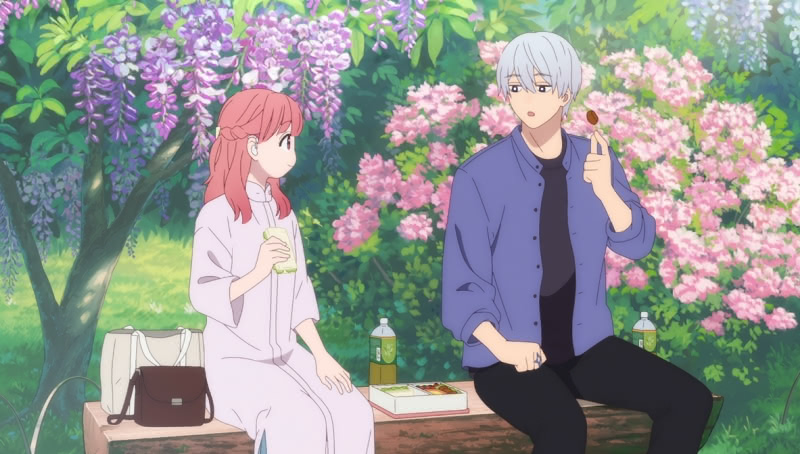
I agree with some complaints that I read regarding early episodes that Itsuomi is too hands-on with Yuki when they first meet. This is one area where the show lapses into what we can describe as a genre cliche for romances aimed at female audiences where the attractive guy is physically affectionate with the “ordinary” girl without having a real basis for behaving that way. What makes it peculiar is that once Itsuomi and Yuki are clearly on course to begin dating, Itsuomi is admirably respectful and understanding of Yuki (I dare say that Itsuomi’s understanding of Yuki is supposed to be his most attractive quality). Itsuomi intuitively grasps that Yuki has no experience with dating or relationships and that she likes him even though she does not always show her affection in the way one might expect of a typical 19-year old in the 2010s. It is odd that Itsuomi behaves much more like a genre stereotype in the first couple of episodes than he does when he is actually in a relationship with Yuki. This is a minor knock on the first few episodes of A Sign of Affection in light of the better portrayal of Itsuomi after his introduction.
(For whatever it is worth – Yuki is good with Itsuomi’s tendency to touch her head and face in the early episodes when in some ways she appears less twitchy around Itsuomi than when they actually start dating. This too can be marked up to genre convenience in a show that otherwise aspires to anime realism.)
While I like Yuki as a character and I appreciated the lengths to which the series goes to explore her backstory, the season does not do quite enough to develop Yuki as a person apart from her deafness and her being in love with Itsuomi. For example, it is not until the very end of the series that we hear Yuki go into detail about something she is interested in. I would have liked to see Yuki rounded out more during the series and I hope that is a point of emphasis if we have a second season in the future. We learn that Yuki has a curfew and that her immediate family does not know sign-language, but her home life is otherwise similarly left on the back-burner.
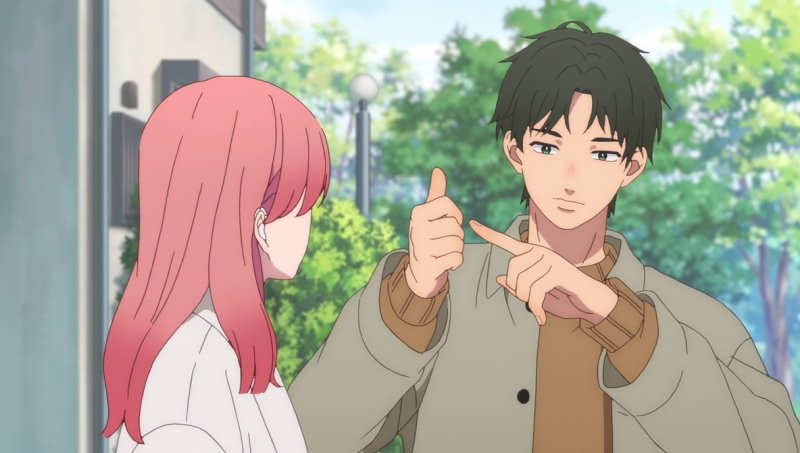
The most significant characters outside of Yuki and Itsuomi are Shin and Oushi, both of whom are the main focus of at least one episode. Shin eventually gets a full backstory showing the history of his relationship with Itsuomi and Ema (Shin’s story is not directly relevant to Yuki). I enjoyed Shin’s episode more than I thought I would and it felt surprisingly natural in light of the fact that Shin had mostly been a bit player until that point. Shin’s story is an example of why I noted that an irony in the show is that Itsuomi and Yuki communicate better through their initial communication barriers than most people do in the absence of deafness or similar impediments. Oushi is the only character who has a tendency to come off as unpleasant (one’s mileage with Ema may vary). It is obvious from his introduction that he studies sign language because of Yuki. Yet he acts immature toward Yuki and opposes her efforts to move out of her comfort zone. Oushi’s character is never fully redeemed, but I will say without going into unnecessary detail that the series does give him a chance to account for himself that leaves one with hope for his positive character development in the future. (Note: My article on Itsuomi’s hair color experiments indirectly covers the show’s main Oushi episode.)
Rin, Kyouya, and Ema are not developed in as much detail. Rin and Kyouya have their own development together in the first season, but their main role in the series is to serve as support for Yuki and Itsuomi/Shin respectively (much more in the case of Rin for Yuki, however). Ema receives a full backstory in Shin’s episode, but other than the fact she has a long, unrequited crush on Itsuomi and that she is best friends with Shin, we do not learn much about her in the 12 episodes.
A Sign of Affection is solid throughout but it improves once Yuki and Itsuomi begin dating late in the first half of the series. One reason is thatItsuomi comes off much better in the relationship than he does in some of the early scenes where he is flirting with Yuki. In the context of their relationship, the show strikes an interesting balance with Itsuomi. I noted that Itsuomi is very respectful of Yuki as a girlfriend and cognizant of the fact that she lived in a very small world for most of her life. At the same time, however, Itsuomi treats Yuki like an adult woman – while Oushi, her family, and others do not There is a story-line in which Yuki decides to do something outside of her comfort zone that may well not be necessary for the reason why she wants to do it. Itsuomi, instead of discouraging her, recognizes that Yuki wants to take a step toward independence and offers her his moral support. A less well written show may have inadvertently portrayed Itsuomi as treating Yuki like an object or someone who lacks agency – but A Sign of Affection is a deft enough piece to understand how to write a likable character. Another point that makes the relationship interesting is Itsuomi’s interest in learning about how Yuki sees the world. This too makes sense. He travels to foreign countries and learns new languages so he can meet new people and learn about different cultures. In Yuki, he saw someone who had a unique way of seeing and experiencing the place he called home – and he took an immediate interest in wanting to understand how she sees the world. While Itsuomi and Yuki are the most interesting characters in A Sign of Affection, the secondary characters were well-written and carry their comparatively smaller number of scenes.
Concluding anime adaptations of ongoing source material is always tricky since source material does not always have a neat and tidy cut-off point. A Sign of Affection has a definite in medias res ending in that it does not conclude with a dramatic event and resolution (note again that Yuki and Itsuomi begin dating early in the season). With that being said, A Sign of Affection came up with a good end-point under the circumstance, focusing primarily on Yuki and Itsuomi while also highlighting the progress that all of the other significant cast members made in the season. The number of unfinished (or just starting) plot threads demands a second season – and while none has been announced, I would not be surprised if we see one down the line.
Opening and Ending Songs
A Sign of Affection goes above and beyond for both its opening and ending sequences. The opening is gorgeous and well-animated and accompanied by the solid song Yuki no Ne (Novelbright) (see opening sequence).
The ending fills in still black and white images with watercolors and is quite pretty, albeit the animation segues into an episode preview while the very solid ending song, Snow Spring (ChoQMay), is still playing (see ending sequence). The beginning of the ending song fits the series very well and makes for a great transition for ending episodes. It is of sufficient quality to be an early year-end honorable mention candidate for best opening or ending.
My Assessment
While A Sign of Affection is a strong anime, it is at least one notch below the caliber of series I typically consider for anime of the year – albeit it would have been in the mix in weaker years such as last year (2023) and in 2019. While I generally prefer the second half of the season to the first, it maintains a fairly consistent episode-to-episode quality, and I credit it for concluding about as well as it could under the circumstances of the adaptation. It is held back from the tier of a typical series of the year type show by a couple of factors.
Firstly, A Sign of Affection lacks the extra gear of the best anime. My anime of the year type shows tend to have moments of greatness – scenes or in some cases entire episodes that come to define the series or even the year in anime. For example, I could make a fair case that A Sign of Affection was more consistent episode-to-episode than my top two series of 2023, Overtake! and Oshi no Ko respectively. But I would have ranked it third on my list of best 2023 seasons had it run in 2023 instead of 2024. Overtake! had two great episodes late in its run which ended up elevating what had been a solid series to the best series of 2023. Oshi no Ko was inconsistent to say the least but it has a remarkable tendency to end episodes with dramatic flourishes, delivering the best scenes of 2023 and a few of the best scenes of any year. With the possible exception of Yuki’s flashback in episode 2, A Sign of Affection is missing those defining moments or great episodes. There are rare cases where a series reaches the series of the year tier without an extra gear. Shirobako, a show about making anime, was nearly my 2015 series of the year despite, with one late exception, not having an extra gear. Tsuki ga Kirei, a subdued middle school romance, was my 2017 series of the year and one of my favorite series of all time despite only having one gear – but A Sign of Affection’s baseline is good instead of great.
Secondly, while I think A Sign of Affection is a strong adaptation that elevated the source material and found a good way to wrap up the season despite ending in the middle of an ongoing story, the first season – without the benefit of a second – introduces more characters than it can fully flesh out. Beyond my small complaint that Yuki needs further development as a person, the side characters are overly defined by who they like rather than who they are. Rin, Kyouya, and Ema are the three main examples of the issue. I appreciated the work that the series put into Shin and Oushi, but even they are still somewhat under-developed based on the first 12 episodes alone (one could make a fair case that Oushi’s main aesthetic purpose is to serve as a contrast to Itsuomi). If we get a second season, I hope we learn more about the characters as people (as for Yuki, more about her impulses, interests, and life apart from Itsuomi)
Conclusion
A Sign of Affection is one of the best serious anime romances in recent years. The series distinguishes itself by having a deaf protagonist, but there is much to recommend it beyond Yuki’s well-portrayed disability. Its animation and overall aesthetic is exceptional for the genre and, while the series is not notably ambitious, it benefits from its careful writing and attention to detail. Itsuomi has a few off-putting moments in early episodes, but the show then mostly breaks free of genre e and presents Itsuomi as an unusually mature and thoughtful character for the better part of the 12 episodes.
Despite my general praise, I give A Sign of Affection a qualified recommendation for general audiences. It is a must-try for anyone who likes anime romances, especially of the shoujo/josei variety, for those featuring characters older than the common grades 6-12 set, or for anyone who has a particular interest in seeing an anime that portrays a deaf character. But as solid as the series is, there is nothing that singles it out for recommendation for people who lack patience for the genre or set-up or who do not have a specific interest in seeing how Yuki’s character is handled. Nevertheless, in light of the fact I noted that A Sign of Affection would have been my third-ranked series of 2023, it should go without saying that I consider it to be an early 2024 top-six candidate, but we will have to wait about nine months to see where it lands (or if it lands) on my final list.
